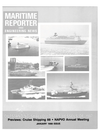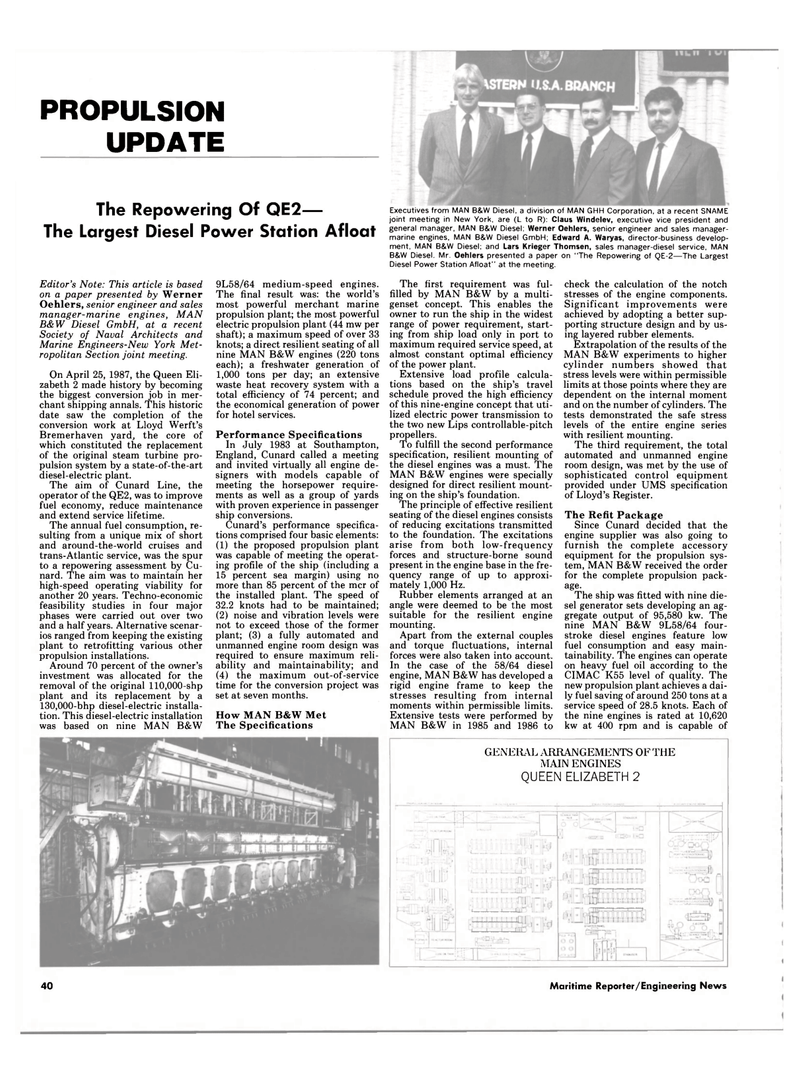
Page 40: of Maritime Reporter Magazine (January 1988)
Read this page in Pdf, Flash or Html5 edition of January 1988 Maritime Reporter Magazine
PROPULSION
UPDATE
The Repowering Of QE2—
The Largest Diesel Power Station Afloat
Editor's Note: This article is based on a paper presented by Werner
Oehlers, senior engineer and sales manager-marine engines, MAN
B&W Diesel GmbH, at a recent
Society of Naval Architects and
Marine Engineers-New York Met- ropolitan Section joint meeting.
On April 25, 1987, the Queen Eli- zabeth 2 made history by becoming the biggest conversion job in mer- chant shipping annals. This historic date saw the completion of the conversion work at Lloyd Werft's
Bremerhaven yard, the core of which constituted the replacement of the original steam turbine pro- pulsion system by a state-of-the-art diesel-electric plant.
The aim of Cunard Line, the operator of the QE2, was to improve fuel economy, reduce maintenance and extend service lifetime.
The annual fuel consumption, re- sulting from a unique mix of short and around-the-world cruises and trans-Atlantic service, was the spur to a repowering assessment by Cu- nard. The aim was to maintain her high-speed operating viability for another 20 years. Techno-economic feasibility studies in four major phases were carried out over two and a half years. Alternative scenar- ios ranged from keeping the existing plant to retrofitting various other propulsion installations.
Around 70 percent of the owner's investment was allocated for the removal of the original 110,000-shp plant and its replacement by a 130,000-bhp diesel-electric installa- tion. This diesel-electric installation was based on nine MAN B&W 9L58/64 medium-speed engines.
The final result was: the world's most powerful merchant marine propulsion plant; the most powerful electric propulsion plant (44 mw per shaft); a maximum speed of over 33 knots; a direct resilient seating of all nine MAN B&W engines (220 tons each); a freshwater generation of 1,000 tons per day; an extensive waste heat recovery system with a total efficiency of 74 percent; and the economical generation of power for hotel services.
Performance Specifications
In July 1983 at Southampton,
England, Cunard called a meeting and invited virtually all engine de- signers with models capable of meeting the horsepower require- ments as well as a group of yards with proven experience in passenger ship conversions.
Cunard's performance specifica- tions comprised four basic elements: (1) the proposed propulsion plant was capable of meeting the operat- ing profile of the ship (including a 15 percent sea margin) using no more than 85 percent of the mcr of the installed plant. The speed of 32.2 knots had to be maintained; (2) noise and vibration levels were not to exceed those of the former plant; (3) a fully automated and unmanned engine room design was required to ensure maximum reli- ability and maintainability; and (4) the maximum out-of-service time for the conversion project was set at seven months.
How MAN B&W Met
The Specifications
The first requirement was ful- filled by MAN B&W by a multi- genset concept. This enables the owner to run the ship in the widest range of power requirement, start- ing from ship load only in port to maximum required service speed, at almost constant optimal efficiency of the power plant.
Extensive load profile calcula- tions based on the ship's travel schedule proved the high efficiency of this nine-engine concept that uti- lized electric power transmission to the two new Lips controllable-pitch propellers.
To fulfill the second performance specification, resilient mounting of the diesel engines was a must. The
MAN B&W engines were specially designed for direct resilient mount- ing on the ship's foundation.
The principle of effective resilient seating of the diesel engines consists of reducing excitations transmitted to the foundation. The excitations arise from both low-frequency forces and structure-borne sound present in the engine base in the fre- quency range of up to approxi- mately 1,000 Hz.
Rubber elements arranged at an angle were deemed to be the most suitable for the resilient engine mounting.
Apart from the external couples and torque fluctuations, internal forces were also taken into account.
In the case of the 58/64 diesel engine, MAN B&W has developed a rigid engine frame to keep the stresses resulting from internal moments within permissible limits.
Extensive tests were performed by
MAN B&W in 1985 and 1986 to check the calculation of the notch stresses of the engine components.
Significant improvements were achieved by adopting a better sup- porting structure design and by us- ing layered rubber elements.
Extrapolation of the results of the
MAN B&W experiments to higher cylinder numbers showed that stress levels were within permissible limits at those points where they are dependent on the internal moment and on the number of cylinders. The tests demonstrated the safe stress levels of the entire engine series with resilient mounting.
The third requirement, the total automated and unmanned engine room design, was met by the use of sophisticated control equipment provided under UMS specification of Lloyd's Register.
The Refit Package
Since Cunard decided that the engine supplier was also going to furnish the complete accessory equipment for the propulsion sys- tem, MAN B&W received the order for the complete propulsion pack- age.
The ship was fitted with nine die- sel generator sets developing an ag- gregate output of 95,580 kw. The nine MAN B&W 9L58/64 four- stroke diesel engines feature low fuel consumption and easy main- tainability. The engines can operate on heavy fuel oil according to the
CIMAC K55 level of quality. The new propulsion plant achieves a dai- ly fuel saving of around 250 tons at a service speed of 28.5 knots. Each of the nine engines is rated at 10,620 kw at 400 rpm and is capable of
GENERAL ARRANGEMENTS OF THE
MAIN ENGINES
QUEEN ELIZABETH 2
Executives from MAN B&W Diesel, a division of MAN GHH Corporation, at a recent SNAME joint meeting in New York, are (L to R): Claus Windelev, executive vice president and general manager, MAN B&W Diesel; Werner Oehlers, senior engineer and sales manager- marine engines, MAN B&W Diesel GmbH; Edward A. Waryas, director-business develop- ment, MAN B&W Diesel; and Lars Krieger Thomsen, sales manager-diesel service, MAN
B&W Diesel. Mr. Oehlers presented a paper on "The Repowering of QE-2—The Largest
Diesel Power Station Afloat" at the meeting. 40 Maritime Reporter/Engineering News

 39
39

 41
41
